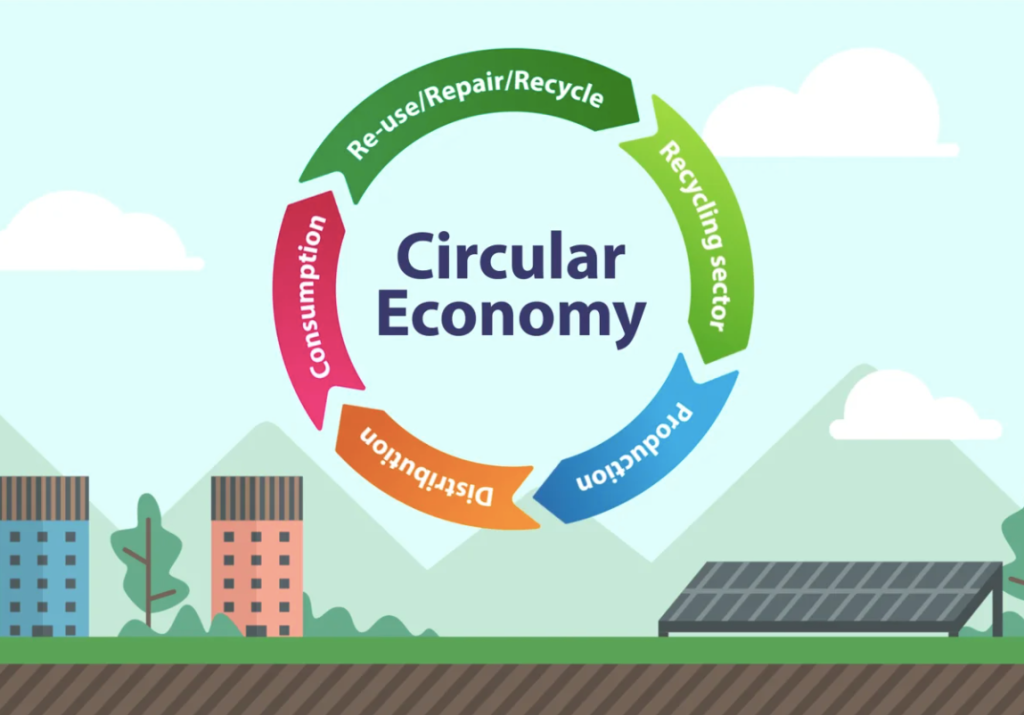In recent years, there has been a growing focus on sustainability and environmental conservation. As the world becomes more aware of the impact of traditional industries on the planet, innovative solutions are being sought to promote resource efficiency. One such solution is the emergence of green cryptocurrencies. In this article, we will explore the concept of green cryptocurrency and its role in advancing the circular economy.
Introduction
The current financial landscape heavily relies on traditional currencies and centralized systems that often neglect the environmental impact of economic activities. Green cryptocurrency, on the other hand, presents a promising alternative that aligns economic transactions with sustainable practices.
Understanding Green Cryptocurrency
Green cryptocurrency refers to digital currencies that are designed to have a minimal carbon footprint and promote environmental sustainability. These cryptocurrencies utilize blockchain technology, which allows for decentralized and transparent transactions. The energy used in validating and recording transactions in green cryptocurrencies predominantly comes from renewable sources, such as solar or wind power.
The Circular Economy: An Overview
The circular economy is an economic model that aims to minimize waste and maximize the use of resources. It promotes the principles of reducing, reusing, and recycling materials to create a closed-loop system. In contrast to the linear “take-make-dispose” approach, the circular economy focuses on extending the lifespan of products and materials through design, repair, and repurposing.
The Link Between Green Cryptocurrency and the Circular Economy

Green cryptocurrency and the circular economy share a common objective of promoting resource efficiency. By integrating the principles of the circular economy into the operations of green cryptocurrencies, it becomes possible to create a more sustainable financial ecosystem. Transactions made with green cryptocurrencies can support businesses and projects that follow circular economy practices, thereby driving the transition towards a more sustainable and regenerative economy.
Advantages of Green Cryptocurrency
- Environmental Benefits: Green cryptocurrencies significantly reduce the carbon footprint associated with traditional financial systems, contributing to a greener and more sustainable future.
- Transparency and Trust: Blockchain technology ensures transparency and immutability, allowing for secure and verifiable transactions.
- Incentivizing Sustainable Practices: Green cryptocurrencies can reward individuals and organizations for adopting sustainable behaviors, such as recycling or reducing energy consumption.
- Empowering Local Economies: By supporting local projects and initiatives through green cryptocurrencies, communities can enhance economic resilience and self-sufficiency.
Challenges and Limitations
- Energy Consumption: Despite efforts to use renewable energy sources, green cryptocurrencies still require a substantial amount of electricity for mining and transaction verification.
- Scalability: Green cryptocurrencies face scalability challenges, as the energy requirements and computing power needed for transactions increase with their popularity.
- Regulatory Frameworks: The regulatory landscape for green cryptocurrencies is still evolving, and clear guidelines are needed to ensure their proper integration into existing financial systems.
Case Studies: Green Cryptocurrency Initiatives
Several green cryptocurrency initiatives have emerged to demonstrate the practical application and benefits of this innovative approach. Two notable examples are SolarCoin and Chia Network.
SolarCoin is a green cryptocurrency that incentivizes the production of solar energy. Individuals and organizations receive SolarCoins for every megawatt-hour of solar energy they generate. This initiative aims to promote the adoption of solar energy and contribute to a greener future by rewarding participants for their renewable energy contributions.
Chia Network, on the other hand, focuses on addressing the energy consumption concerns associated with traditional cryptocurrencies. Chia Network utilizes a more energy-efficient consensus algorithm called Proof of Space and Time (PoST) instead of the energy-intensive Proof of Work (PoW) algorithm used by Bitcoin. By leveraging unused storage space on users’ devices, Chia Network aims to significantly reduce the energy footprint of cryptocurrency mining while maintaining the security and decentralization features.
These case studies highlight the diverse approaches and innovations within the realm of green cryptocurrencies, showcasing the potential for sustainable and resource-efficient financial systems.
Future Prospects and Implications
The future prospects of green cryptocurrencies are promising. As technology advances and renewable energy becomes more accessible and cost-effective, the integration of green cryptocurrencies into mainstream financial systems becomes increasingly feasible. The potential benefits of reduced carbon emissions, increased transparency, and incentivization of sustainable practices make green cryptocurrencies an attractive option for individuals and businesses alike.
Furthermore, the implications of widespread adoption of green cryptocurrencies extend beyond financial transactions. They can drive systemic change by encouraging resource efficiency, promoting sustainable consumption and production patterns, and contributing to the broader transition towards a circular economy. Green cryptocurrencies have the potential to reshape the global economy, placing sustainability at the core of financial systems and fostering a more environmentally conscious society.
Green Cryptocurrency and Sustainable Investments
Green cryptocurrency presents an exciting opportunity for sustainable investments. As individuals and institutions increasingly seek investment options that align with their values and promote positive environmental impacts, green cryptocurrency offers a new avenue for sustainable investing. By investing in green cryptocurrencies, individuals can support projects and initiatives that contribute to resource efficiency, renewable energy adoption, and the circular economy. These investments can not only generate financial returns but also contribute to positive environmental outcomes, fostering a more sustainable and regenerative economy.
Green Cryptocurrency and Decentralized Governance
Green cryptocurrencies also introduce the concept of decentralized governance. Traditional financial systems are often centralized, controlled by a select few entities. In contrast, green cryptocurrencies leverage blockchain technology to enable decentralized decision-making and governance. Through decentralized governance models, holders of green tokens have the opportunity to participate in decision-making processes, such as determining the direction of the cryptocurrency’s development, allocating funds for sustainable projects, or proposing and voting on changes to the system. This democratization of decision-making power empowers individuals and fosters a sense of community ownership in shaping the future of green cryptocurrencies and their impact on the circular economy.
Green Cryptocurrency and Social Impact
The integration of green cryptocurrency into the circular economy can have significant social impact as well. By leveraging the principles of the circular economy and sustainable development, green cryptocurrencies can support initiatives that prioritize social equity, job creation, and community development. For example, green cryptocurrency projects can prioritize funding for renewable energy projects in underserved communities, providing access to clean energy and economic opportunities. Additionally, by incorporating social impact metrics into the evaluation of projects and initiatives, green cryptocurrencies can ensure that investments align with both environmental and social goals, promoting a more inclusive and equitable transition towards a circular economy.
Green Cryptocurrency and Education
Green cryptocurrency also has the potential to drive educational initiatives focused on sustainability and the circular economy. The transparent and decentralized nature of green cryptocurrencies allows for the creation of educational platforms and resources that raise awareness about environmental issues, promote sustainable practices, and foster a better understanding of blockchain technology. Through educational programs, individuals can learn about the benefits of green cryptocurrency, how it supports the circular economy, and how they can actively participate in shaping a more sustainable future. This educational aspect of green cryptocurrency contributes to building a knowledgeable and engaged community that values resource efficiency and actively seeks solutions for a greener world.
As the world continues to explore the potential of green cryptocurrency and its role in advancing the circular economy, these emerging subtopics present exciting avenues for innovation, impact, and positive change. By embracing sustainable investments, decentralized governance, social impact initiatives, and educational efforts, green cryptocurrency can contribute to a more sustainable, equitable, and circular economic system.
Green Cryptocurrency and Sustainable Supply Chains
Green cryptocurrency can play a vital role in promoting sustainable supply chains. By incorporating blockchain technology, green cryptocurrencies enable transparent and traceable transactions throughout the supply chain. This transparency allows consumers and businesses to track the origin and lifecycle of products, ensuring that they are produced and distributed in an environmentally responsible manner. Green cryptocurrencies can incentivize sustainable practices within the supply chain, such as using eco-friendly materials, reducing waste, and supporting fair labor practices. By integrating green cryptocurrency into supply chain management, companies can foster greater transparency, accountability, and sustainability throughout their operations.
Green Cryptocurrency and Carbon Offsetting
Green cryptocurrency can also be utilized as a tool for carbon offsetting. Carbon offsetting involves investing in projects or initiatives that reduce or remove greenhouse gas emissions to compensate for an individual’s or organization’s carbon footprint. Green cryptocurrencies can enable individuals and businesses to participate in carbon offsetting by supporting specific projects through the use of tokens. For example, green tokens can be used to fund reforestation projects, renewable energy installations, or initiatives focused on energy efficiency. This direct connection between green cryptocurrency and carbon offsetting provides an accessible and transparent way for individuals and businesses to take responsibility for their emissions and contribute to global climate mitigation efforts.
Green Cryptocurrency and Circular Design
Circular design, a key aspect of the circular economy, focuses on creating products and systems that are regenerative and minimize waste throughout their lifecycle. Green cryptocurrency can incentivize and support circular design principles by providing funding and recognition for projects that embrace these principles. For instance, green tokens can be used to reward businesses that adopt circular design practices, such as using recyclable or biodegradable materials, implementing product take-back programs, or designing products for longevity and easy repair. By integrating green cryptocurrency into the promotion of circular design, a symbiotic relationship is formed, where the cryptocurrency supports sustainable design practices, and the circular design principles contribute to the overall sustainability of the cryptocurrency ecosystem.
Green Cryptocurrency and Technological Innovation
Green cryptocurrency and the circular economy are closely intertwined with technological innovation. The advancement of technologies such as blockchain, Internet of Things (IoT), and artificial intelligence (AI) can enhance the efficiency and impact of green cryptocurrencies. For example, IoT devices can be used to monitor and optimize resource consumption, ensuring that transactions made with green cryptocurrencies align with sustainable practices. AI algorithms can analyze data to identify patterns and optimize resource allocation within the cryptocurrency ecosystem. These technological advancements can improve the accuracy, transparency, and effectiveness of green cryptocurrencies, accelerating the transition towards a resource-efficient and sustainable future.
As green cryptocurrency continues to evolve and intersect with various domains, these subtopics highlight the potential for leveraging this innovative concept to drive sustainable supply chains, carbon offsetting, circular design, and technological innovation. By integrating green cryptocurrency into these areas, we can harness its power to create positive environmental, social, and economic impacts.
Conclusion
In conclusion, green cryptocurrencies offer a unique opportunity to promote resource efficiency by aligning financial transactions with sustainable practices. While they face challenges, such as energy consumption and scalability, these can be addressed through technological advancements and regulatory frameworks. By leveraging the advantages of green cryptocurrencies, such as environmental benefits, transparency, and incentivization, we can pave the way for a greener and more sustainable future.
Pranav is a tech, crypto & blockchain writer based in London. He has been following the development of blockchain technology for several years.




